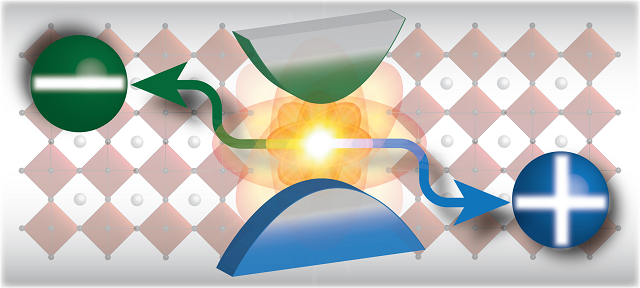
Organic-inorganic “hybrid” perovskites. Image courtesy: University of Notre Dame.
University of Notre Dame researchers have studied the basic optical properties of organic-inorganic "hybrid" perovskites, a new class of semiconducting materials. The study results are published in the journal, Nature Photonics.
Joseph Manser, who is a doctoral student in chemical and biomolecular engineering, performed the study at the Notre Dame Radiation Laboratory, under the guidance of Prashant Kamat, Rev. John A. Zahm Professor of Science. The structural order adopted by these semiconducting materials when dried and assembled in the solid state is referred to as "perovskites."
Manser speaking exclusively to AZoM.com said:
Our paper published earlier this week focuses on the fundamental optical and electronic properties of hybrid perovskites with the aim to elucidate what makes these materials so well suited for photovoltaic applications.
Joseph Manser - Doctoral Student, University of Notre Dame
According to Manser, even though perovskite solar cells have shown a drastic improvement in performance within the last few years, the scientific community lacks clear understanding of the fundamental optical properties of these novel materials.
Using "transient absorption pump-probe spectroscopy", Manser and Kamat investigated the events that take place trillions of a second subsequent to absorption of light by the hybrid methylammonium lead iodide.
Spectral broadening and relaxation pathway in the photoexcited hybrid methylammonium lead iodide were analyzed. What they found was the presence of separate and unique electrons and holes called "free carriers" in the photoexcited hybrid methylammonium lead iodide.
Whilst discussing the findings with AZoM.com, Manser explained, "the results of this work revealed that following the absorption of visible light, the hybrid perovskite excited state is composed primarily of separated or unbound positive and negative charges that can be directly extracted to generate current.".
"This observation is surprising given the fact that this type of behavior is typically seen in highly-crystalline materials that are processed at elevated temperatures and not in solution-cast films," Manser said. "Our findings can in part explain why these materials operate so efficiently as light absorbing materials in low-cost solar cells and can potentially aid in optimization of perovskite solar cell architecture."
The presence of the photoexcited charges in an intrinsically unbound state in the hybrid perovskites eliminates the additional energy loss caused by the interfacial change separation, he said. The study results reveal that hybrid perovskites show promise to alleviate the compromise between high-performance and low-cost in light-harvesting devices, he concluded.